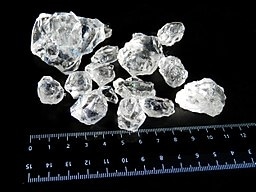
Carnallite
Carnallite (also carnalite) is an evaporite mineral, a hydrated potassium magnesium chloride with formula KCl.MgCl2·6(H2O). It is variably colored yellow to white, reddish, and sometimes colorless or blue. It is usually massive to fibrous with rare pseudohexagonal orthorhombic crystals. The mineral is deliquescent (absorbs moisture from the surrounding air) and specimens must be stored in an airtight container.
Carnallite occurs with a sequence of potassium and magnesium evaporite minerals: sylvite, kainite, picromerite, polyhalite, and kieserite. Carnallite is an uncommon double chloride mineral that only forms under specific environmental conditions in an evaporating sea or sedimentary basin. It is mined for both potassium and magnesium and occurs in the evaporite deposits of Carlsbad, New Mexico; the Paradox Basin in Colorado and Utah; Stassfurt, Germany; the Perm Basin, Russia; and the Williston Basin in Saskatchewan, Canada. These deposits date from the Devonian through the Permian Periods. In contrast, both Israel and Jordan produce potash from the Dead Sea by using evaporation pans to further concentrate the brine until carnallite precipitates, dredging the carnallite from the pans, and processing to remove the magnesium chloride from the potassium chloride.Carnallite was first described in 1856 from its type location of Stassfurt Deposit, Saxony-Anhalt, Germany. It was named for the Prussian mining engineer Rudolf von Carnall (1804–1874).

